7 Days Bhutan Group Tour: Paro, Thimphu, Punakha (Cultural Experiences)

-
Tour Code: AOT-BT-B1
-
Travel Route: Paro - Thimphu - Punakha - Paro
-
Features: Buddhist, Culture, Religious Monuments, Museums, Arts and Crafts, Markets, Nature, Hiking, Valley, River, Mountain, Himalayan View, Villages
-
Tour Type: Small Group of maximum 14 travelers, guaranteed departures;
-
Guide & Driver: English-speaking guide, experienced driver with a regular tourist vehicle
-
Accommodation: 6 nights at 3 Star Standard Hotel
- Itinerary
- Dates & Price
- Accommodation
- Trip Notes
- Reviews
Have you ever wondered why Bhutan is considered the happiest country on the planet? Despite not being a developed nation, what is the secret to the happiness of the Bhutanese people? How do they benefit from globalization while simultaneously ensuring that the unique culture cherished by the Bhutanese remains unspoiled?
Discover the secrets of happiness with our 7 Days Bhutan Culture Tour, a journey through the heart of Paro, Thimphu, and Punakha. Start your journey in Paro, where the ethereal beauty of the Tiger's Nest Monastery awaits you, perched dramatically on a cliffside. Stroll through the oldest Kyichu Lhakhang, visit the Paro Dzong, Bhutan National Museum, and immerse yourself in the rich tapestry of Bhutanese heritage. In Thimphu, the capital, witness the grandeur of Tashichho Dzong and the towering Buddha Dordenma Statue, symbolizing peace and stability. Engage with the local culture by visiting markets and museums, offering a glimpse into the Bhutanese way of life. As you journey to Punakha, be mesmerized by the panoramic Himalaya views at Dochula Pass and the architectural marvel that is Punakha Dzong. Walk across the longest suspension bridge in Bhutan, and visit the fertility temple, Chimi Lhakhang, nestled in the picturesque countryside.
Throughout your journey, engage with the warm-hearted locals, explore local markets learn colorful textiles and handicrafts, and savor the flavors of Bhutanese cuisine, wear Bhutanese Traditional attire and visit Buddhism monasteries to understand the spiritual depth of Bhutanese. Our experienced local guides will lead you through this mystical land, offering insights into the philosophy of Gross National Happiness and how it is woven into the fabric of everyday life. Join us on this 7 Days Bhutan Culture Tour in Small Group and immerse yourself in the magic of Bhutan, where happiness is a place, and discover how you can carry a piece of it back home with you.
Itinerary at a Glance
Paro (2 Days)
Tiger's Nest Monastery, Kyichu Lhakhang, Tamchog Lhakhang Iron Bridge, Paro Dzong, Bhutan National Museum (Ta Dzong)
Thimphu (2 Days)
Buddha Dordenma Statue (Buddha Point), National Memorial Chorten, Tashichho Dzong (Thimphu Dzong), Motithang Takin Preserve
Punakha (3 Days)
Dochula Pass, Chimi Lhakhang, Punakha Dzong, Khamsum Yulley Namgyal Chorten, Punakha Suspension Bridge, Sangchhen Dorji Lhuendrup Nunnery
Itinerary Day by Day
Tashi Delek! Welcome to Bhutan, the Last Shangri La in Pristine Himalayan Kingdom. Take a deep breath and enjoy the refreshing breeze in the happy country where 71% of the land is covered with forests. Your guide will greet you at Paro International Airport, Bhutan's only international airport.
Paro (2,270m) is the first city for most guests to reach Bhutan. It is known for Tiger's Nest which makes Paro a must-visit destination in Bhutan. For nature and culture lovers, Paro is a picturesque place that combines spirituality, natural beauty, and cultural heritage. You may have the chance to attend the colorful annual Paro Tshechu Festival if you visit Paro in early to mid-March. The festival falls on the 10th day of the second lunar month of the Bhutanese calendar. In some years, the festival might start slightly earlier, around March 10th or 15th. The festival celebrates the birthday of Guru Rinpoche, a revered figure in Bhutanese Buddhism.
You will not miss a stop at the Paro Airport Birds Eye View Point on the way to you hotel, which is a great spot to enjoy a panorama view of Paro Airport, Rinpung Dzong (Paro Dzong), National Museum (Ta Dzong), Paro Chu River, and the stunning Paro Valley itself. Don't forget to ask your guide for more fascinating information about this remarkable airport. Afterward, you can check in at your cozy hotel, where you can rest and acclimate yourself to any time difference.
You will enjoy the following complimentary experiences from the AOT:
1.Bhutan National Dress Experience: Try Bhutan Traditional Attire, Gho for Men & Kira for Women. The Gho and Kira are typically made from woven fabrics with intricate patterns and designs, reflecting the country's textile heritage.
2.A Bottle of Bhutan Red Rice Wine: Try Bhutan red rice wine, a traditional alcoholic beverage made by fermenting red rice, a staple crop in Bhutan. It has a lower alcohol content and is typically sweeter than beer.
Base on all group members reach Paro Airport before noon, if time permits, you can ask your guide to take you to Rinpung Dzong (Paro Dzong) and Bhutan National Museum (Ta Dzong) as the first destinations (self-pay for the tickets). Please note that Paro Dzong is open from 9 AM to 5 PM on weekdays and from 10 AM to 4 PM on weekends. It is required to have a tour guide accompany you when visiting the Dzongs. Before entering for a visit, security checks might be conducted.
Free Time Ideas:
1. Visit Paro Local Market or Street: Why not dress in Bhutan's National attire to visit a local market or Paro's main street? Check what Bhutanese eat and what ingredients are used in Bhutan Dishes. Colorful Chili peppers, dry cheese, potatoes, apples...
2. Try Bhutan National Sport (self-pay for the fee): Archery is the favorite pastime for Bhutanese. It has a history of over 2,000 years and was declared Bhutan's National Sport in 1971. Targets at traditional Bhutanese tournaments are placed at both ends of a 140m range (Olympic distance is 70m). Enjoy your time by holding a bow and arrow.
Feel free to contact your guide in advance for more travel advice and tips tailored to your interests.
Arrival Ideas:
Bhutan is situated between Tibet in China to the north and India to the south. To reach Bhutan, you can either travel by air to Paro International Airport, the country's only international airport, or by land through the entry points of Phuentsholing or Gelephu from India. Bhutan's national carrier Druk Air, Bhutan Airlines, and other international airlines, operate regular flights to Paro from major cities like Delhi (India), Kolkata (India),Bagdogra (India), Gaya (India), Guwahati (India), Dhaka (Bangladesh), Bangkok (Thailand), Kathmandu (Nepal), and Changi (Singapore). There will be some charter flights to Paro from Hong Kong (China) and Kuala Lumpur (Malaysia), on a seasonal basis. Around 30,000 people arrive at Paro Airport every year.
Kind Reminds:
1.You can contact us to book your flight to Paro and land directly in Bhutan.
2. Visitors of all nationalities, except those from India (require a permit), require an E-visa (40USD/pax) before entering Bhutan. All nationalities are welcome to visit Bhutan, and there are no specific restrictions on granting visas to enter the country.
3. Visitors from India are able to apply for a permit but are required to hold an Indian passport or an Indian voter ID card.
4. Visitors from Bangladesh and the Maldives also require a visa, which can be applied for and approved in advance of travel or upon arrival in Bhutan.


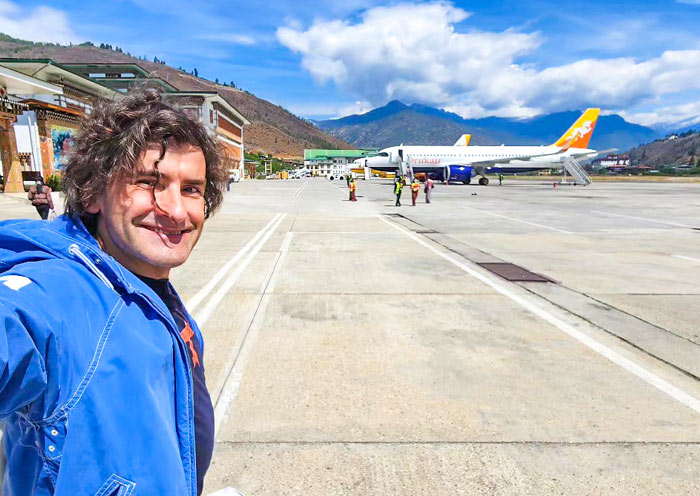
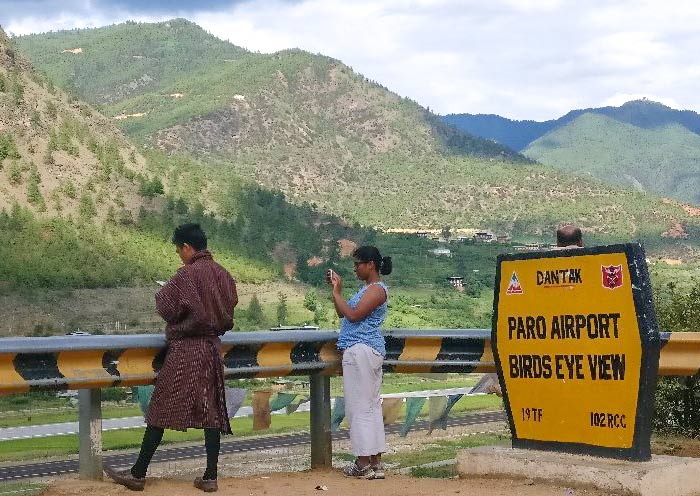
Attractions
Explore according to your flight time
Transportation
Vehicle
Dining
Dinner
Accommodation
Paro
This morning, you will get ready to start the exciting Hiking Tour to Tiger's Nest, the landmark of Bhutan and the most famous holy monastery in the country. It is about a 12km drive (over 0.5 hour) from Paro City to the start point of the Tiger's Nest hike route.
Usually, it may takes about 2.5 hours to reach Tiger's Nest Monastery (Paro Taktsang) on foot. The entire Tiger's Nest Hike takes around 5 to 6 hours, with about 4.8 km of uphill trekking and about 4.8 km of downhill walking. Riding a horse (Optional; Self-payment required), it takes about 1.5 hours to reach the halfway point on the mountainside. From there, you need to say goodbye to your horse and hike for another 1.5 hours to reach the Tiger's Nest Monastery. At the halfway point, there is a Taktsang Cafeteria where you can have a buffet lunch and enjoy coffee and tea. What is more it is the first viewpoint where you can look up at Tiger's Nest Monastery, the incredible religious site of Buddhists. As the viewing position ascends, the outline of Tiger's Nest Monastery becomes increasingly clear. On the journey ahead, you can enjoy the hike in Bhutan’s forest and will see more and more prayer flags and prayer wheels, left behind by the Bhutanese people who come here to worship. You will also have a panoramic view of the beautiful Paro Valley below. If you visit in April, you will have the opportunity to see the high-altitude rhododendrons blooming, creating a stunning display of red clouds amidst the mountains.
Then, you will stand right opposite the Taktsang Goemba (Tiger's Nest Monastery) and admire Bhutan's most iconic cultural landmark, which is renown as one of the world's top ten super monasteries. The Tiger's Nest (3,120m) is sited on the side of a cliff at a height of 900m above the Paro Valley (2,270m). According to legend, the Indian sage Guru Padmasambhava (Guru Rimpoche, the founder of the Nyingma school of Tibetan Buddhism and the builder of the first monastery in Tibet - Samye Monastery) arrived at the location of Tiger's Nest Monastery in the 8th century. It is said that he rode a tigress and subdued demons before spending 3 months meditating in the mountain caves here. This eventually led to the formation of the present-day Tiger's Nest Monastery. Throughout history, this place has been considered a sacred site by Buddhist luminaries. However, it wasn't until 1692 that the current structure of Tiger's Nest Monastery took shape. In 1998, a devastating fire caused significant damage, but it was reconstructed in 2005, closely resembling the original architectural design. You can also hike into the monastery to explore more (no photo inside). Today, Tiger's Nest Monastery, one of the most visited tourist attractions in Bhutan, is revered as the holiest pilgrimage site for Bhutanese people to visit at least once in a lifetime (It takes pilgrims 5 days to complete their kora, performing one long kowtow/full body prostrations at each step of their journey from the Tamchog Lhakhang Iron Bridge to Tiger's Nest Monastery).
After the Tiger's Nest Hike, it is time to visit Kyichu Lhakhang, also known as the Temple of the Thousand-armed and Thousand-eyed Avalokiteshvara. It is one of the 108 Buddhist temples built by King Songtsen Gampo in the 7th century (around 659 AD), and it is believed to have been constructed to subdue the left leg of the Tibetan witch. Kyichu Lhakhang is also one of the oldest Tibetan Buddhist temples in Bhutan and serves as a venue for important celebrations of the Bhutanese royal family. In the main hall of Kyichu Lhakhang, you can see the revered statue of an eight-year-old Shakyamuni Buddha, believed to have been created during the same period as the Jowo statue in the Ramoche Temple in Lhasa, Tibet. It is considered a national treasure of the Kingdom of Bhutan. Apart from housing many precious historical artifacts and Buddhist scriptures, the temple also enshrines the relic stupa of Dilgo Khyentse Rinpoche (1910-1991), a renowned master of the Nyingma tradition. Additionally, there is a piece of iron chain forged by Tangtong Gyalpo, who was the former head of the four major Tibetan Buddhist schools and is known as the Iron Bridge Living Buddha and the father of Tibetan opera.
At last, head back to Paro for overnight.
Optional Bhutan Paro Experiences:
1. Bhutan Traditional Hot Stone Bath (1 hour).
2. Lighting butter lamps for blessings at Kyichu Lhakhang (108 lamps).
Kind Reminds:
1. The best time to visit Tiger's Nest is from March to May and from October to December. After noon, the monastery will be hidden in the shadow of the cliffs, so it's recommended to depart early if you want to capture good photos.
2. Tiger's Nest offers horse riding services to go uphill, but the horse ride is only available up to a designated point. From there, you still need to hike to reach the monastery. When descending, you must walk the entire way as horse riding services are not provided.
3. Mobile phones and backpacks are not allowed inside Tiger's Nest Monastery. Personal belongings can be stored at the entrance. If you wish to light butter lamps, make sure to have some cash ready before storing your belongings.
4. Along the way, you may encounter stray dogs. Please be mindful, give them space, and avoid disturbing them.
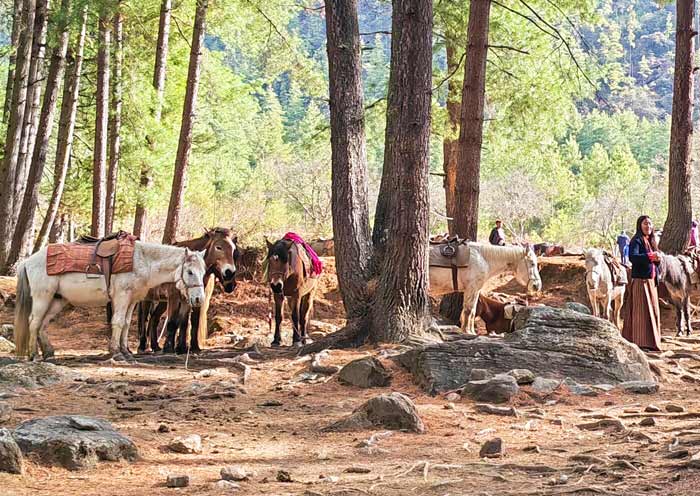


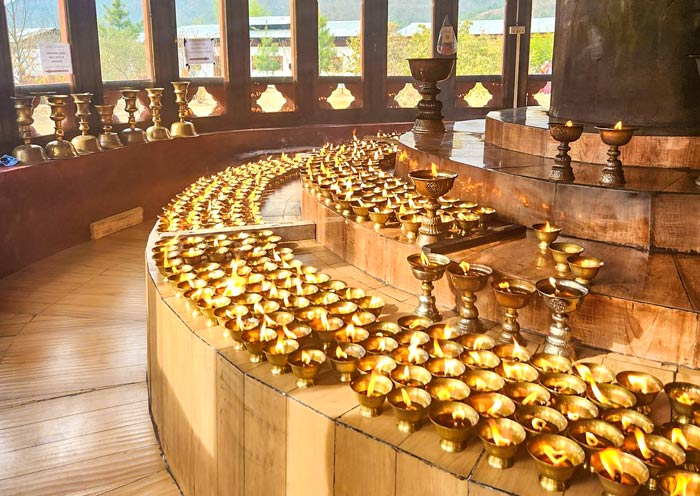
Attractions
2 Iconic Sites
Transportation
Vehicle
Dining
Breakfast, Lunch, Dinner
Accommodation
Paro
Today, we will head to Thimphu, the capital city of Bhutan, which is about 50km away and takes about 1.5 hours to reach. On the way, we will make a stop at Tamchog Lhakhang Iron Bridge for a visit. Once in Thimphu (altitude 2,340m), you will have a full day of sightseeing. You can explore its rich cultural heritage such as the Buddha Dordenma Statue, National Memorial Chorten, Motithang Takin Preserve, and Tashichho Dzong.
From Paro to Thimphu, you won't want to miss visiting the famous Tamchog Lhakhang Iron Bridge (view the Tachog Lhakhang from outside only), situated by the Paro river. There, you will have the opportunity to walk across a unique iron chain bridge adorned with colorful fluttering prayer flags. Both the Lhakhang and the iron bridge were constructed by the revered saint Thangthong Gyalpo (1385 - 1464), who was renowned as the Iron Bridge Maker. Take delight in exploring his historic architectural creations that have stood the test of time. Then, you will visit the iconic landmark of Thimphu City - the Buddha Dordenma Statue (Buddha Point), which is the largest sitting Shakyamuni statue in the world. Completed in 2015, the statue embodies an ancient prophecy of radiating happiness and peace throughout the world. In addition to admiring its impressive height of 51.5 meters, constructed of bronze and gilded in gold, you will also be able to see 125,000 smaller Buddha statues placed within it. During the festival period, visiting here provides the opportunity to witness Buddhist rituals, such as the Vajra Dance Ceremony. Moreover, from this vantage point, you can enjoy a magnificent view of the Thimphu Valley & the red/green roof of Thimphu Buildings.
As the largest city in Bhutan, Thimphu lacks traffic lights and a railway system. When you enter the city, you can visit the National Memorial Chorten and experience it as the locals do. It is customary to follow the footsteps of the Bhutanese people and perform a clockwise kora (circumambulation) around the Chorten while offering prayers. This will provide you with numerous opportunities to engage with the locals and learn about their daily lives, as well as their philosophy on happiness.
The National Memorial Chorten is the most visited landmark in Thimphu. Constructed in 1974 in memory of the Third King, His Majesty Jigme Dorji Wangchuk (known as the Father of Modern Bhutan), by his mother, it reflects the late king's vision of promoting world peace and prosperity. The Chorten follows a Tibetan-style architecture and is adorned with remarkable paintings and intricate sculptures. You can observe the traditional stupa design, featuring a pyramidal pillar topped with a crescent moon and sun. Nature lovers will love to visit the Motithang Takin Preserve to see Bhutan's national animal. There, you can observe the unique creature that is said to have been created by the legendary Drukpa Kunley (Divine Madman). According to legend, Drukpa Kunley fashioned the takin with the head of a goat and the body of a cow.
Sure, you should not miss the visit to Tashichho Dzong (Thimphu Dzong), which has served as the seat of the government since 1952. This magnificent fortress-like structure is located on the western bank of the Wang Chu River. It seamlessly integrates with the entire valley and stands as the ultimate center of power in Bhutan. It houses the offices of the current reigning monarch, the Fifth King (Jigme Khesar Namgyel Wangchuck), as well as the ministries of internal affairs and finance. Additionally, it serves as the residence of the spiritual leader of Bhutan, the Je Khenpo, and hosts the central religious institutions of the country. During the summer season, the Je Khenpo resides in the Thimphu Dzong, while in the winter season, they relocate to Punakha Dzong. Walking around the Dzong, you will discover that it is an impressively large structure surrounded by well-kept lawns and beautiful gardens. Tashichho Dzong has two main entrances. One entrance leads to the administrative section in the south (officials only), while the other, situated in the north, grants access to the monastic quarter where the Thimphu Tshechu Festival (held around Sept. or Oct. yearly) and masked dances are performed.
Note: The tourist opening hours of Thimphu Dzong are from 5 PM to 6:30PM on weekdays and from 10 AM to 4 PM on weekends. It is required to have a tour guide accompany you for a visit to the Dzongs. Before entering for a visit, security checks are conducted. If you visit there at the right time (lucky enough), you may have the chance to see the flag descending ceremony.
Finally, it's time for dinner. You can enjoy a traditional meal at the Folk Heritage Museum Restaurant. Opened as a passion project to promote Bhutanese culinary arts (traditional Bhutan dishes), the restaurant was established by the Queen Mother of Bhutan, Her Majesty Ashi Dorji Wangmo Wangchuck. After dinner, you will spend the night in Thimphu and have a restful sleep.
Optional Bhutan Thimphu Experiences:
1. Folk Heritage Museum: If time permit, you can visit Folk Heritage Museum, a captivating window into Bhutan's rural past & established by the Queen Mother of Bhutan.
2. Simply Bhutan Museum: If time permit, you can visit Simply Bhutan Museum to explore more about Bhutan culture.
3. Bhutan Stamp Printing: Fully functional stamp printed with a self-portrait (Bhutan Post Office: Weekdays: 9AM - 5PM; Saturdays: 9 AM - 1 PM; Closed on Sundays).
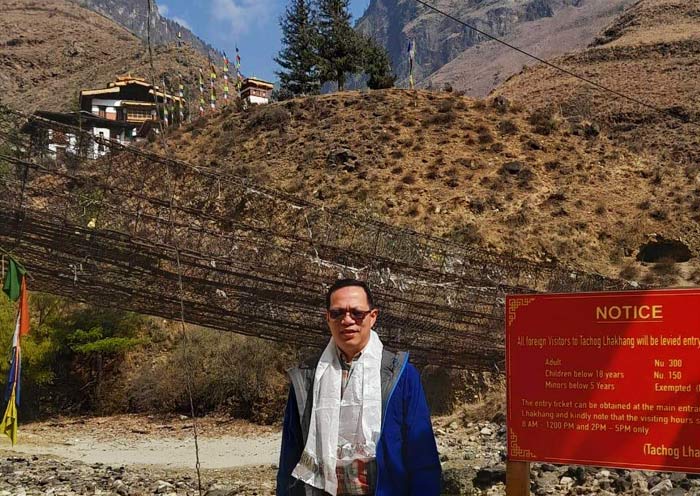
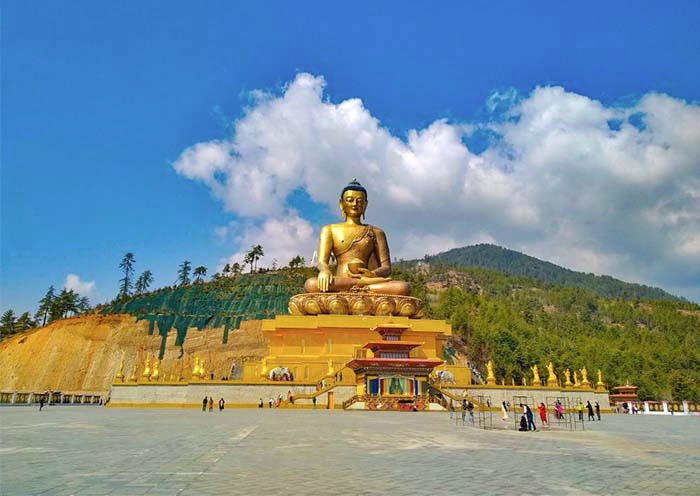
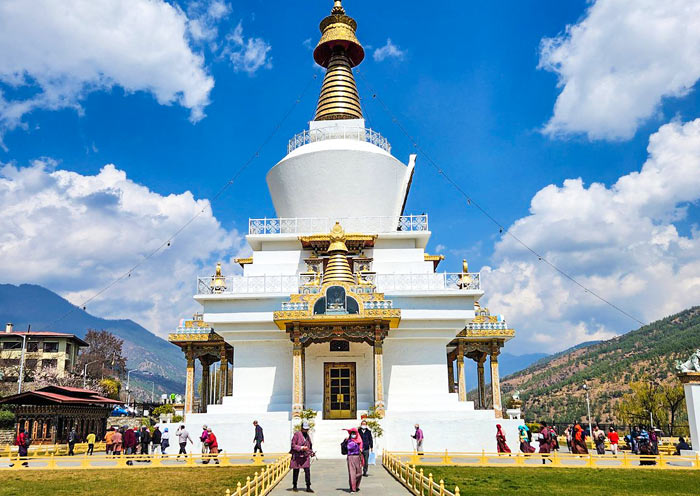
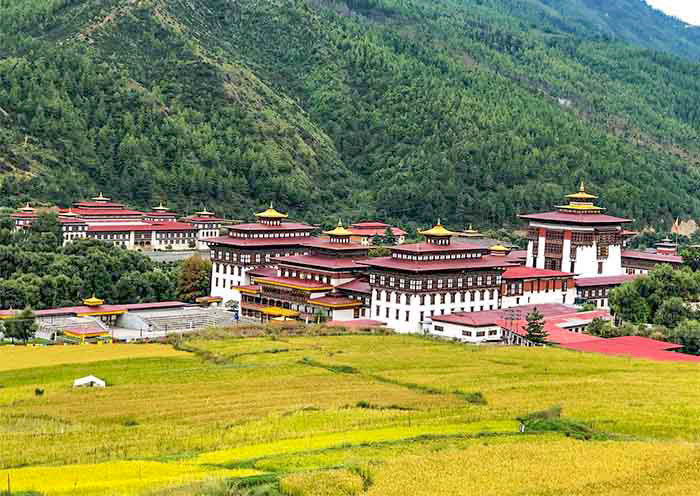
Attractions
5 iconic sites
Transportation
Vehicle
Dining
Breakfast, Lunch, Dinner
Accommodation
Thimphu
Today, you will travel from Thimphu to Punakha via Dochula Pass (74km, about 2.5 hours). This trip is more than just a drive; it is a voyage through changing altitudes and diverse landscapes, offering a visual spectacle. Starting from the higher altitude and cooler climate of Thimphu (2,300m), the drive takes you along the national highway, ascending through the majestic Dochula Pass (3,120m). Upon crossing the pass, you'll descend into the warm and verdant Punakha Valley (1,330m).
En route, you will stop at Dochula Pass (Dochu La Pass), renowned as one of the most beautiful mountain passes in Bhutan. If weather permits, you will be treated to a breathtaking panoramic view of the Himalayas, including Bhutan’s highest mountain peak, Mt. Gangkar Puensum (7,570m). You will have the delightful option to savor the view while enjoying a cup of coffee in the picturesque cafeteria. At the Dochu La Pass summit, you will encounter the 108 memorial chortens (Buddhist shrines) and clusters of prayer flags fluttering in the wind, creating an ambiance of tranquility and spirituality. These chortens (stupas), known as Druk Wangyal Khang Zhang Chortens, were constructed as a memorial to honor the Bhutanese soldiers who lost their lives in the battle against Assamese insurgents from India, and also as an offering for global peace.
Then, your journey continues towards Punakha. Along the way, you will take a hike to Chimi Lhakhang (Chime Lhakhang), which is highly recommended as a culture shock tour. As you stroll through rice paddies and a charming settlement adorned with painted houses and numerous craft shops, you will eventually reach Chimi Lhakhang (Fertility Temple). Constructed by the cousin of Drukpa Kunley, the temple was built to commemorate the victory of Drukpa Kunley (Mad Saint & Divine Madman) over the demon of Dochu La using his "magic thunderbolt of wisdom "(phallus). That is why you can see the symbol of the phallus scattered throughout. Lama Drukpa Kunley was adored by the local people due to his unconventional teaching methods of Buddhism, which involved singing, humor, and an exaggerated manner often intertwined with sexual overtones. Chime Lhakhang is renowned as a sanctuary of fertility, and many childless women sought blessings from the lamas at the monastery. It is believed that these couples often find success in conceiving soon after their visit. If you are lucky, you may encounter the monks there blessing pilgrims or women who wish to conceive by tapping their heads with a 25cm wooden phallus. In Bhutan, it is common for local people to utilize the phallus symbol to ward off the evil eye and deter malicious gossip.
After that, drive to Punakha city, the old capital of Bhutan before 1955. It is located at the confluence of the Mo Chhu (Mother River) and Pho Chhu (Father River). Dominating the river junction is the magnificent Punakha Dzong, the winter residence of Je Khenpo (head abbot of Bhutan) and about 1,000 monks. Occasionally, you'll spot monks draped in red robes passing by, their rhythmic chanting and prayers echoing in the air. Punakha Dzong, the second oldest and second largest Dzong in Bhutan serving administrative and monastic functions holds a legendary tale. It is said that Guru Rinpoche (Padmasambhava) prophesied the arrival of a person named Namgyal built a Dzong on a hill resembling an elephant. In 1637, Shabdrung Ngawang Namgyel, the unifier of Bhutan, received a divine vision guiding him to construct a Dzong at this site. All of Bhutan’s kings have been crowned here and In 2011, the Dzong bore witness to the royal wedding ceremony of His Majesty Jigme Namgyel Wangchuck, the 5th King of Bhutan, as he married Queen Jetsun Pema. As the most beautiful Dzong in Bhutan, if you visit in April, you won’t miss the stunning violet blossoms of the jacaranda tree outside Punakha Dzong. The jacaranda typically blooms from late March to early May, during this time, the grounds of Punakha Dzong transform into a magical carpet of purple under the clear blue skies, creating a truly breathtaking sight. If you visit during the Punakha Tshechu Festival, you can enjoy the mesmerizing masked dances and witness the exhibition of a large thangka depicting the Zhabdrung (Shabdrung, the father of Bhutan) once a year. You can have fun with locals who flood here dressed in Bhutan’s national attire, with men wearing Gho and women wearing Kira.
After crossing the Bazam Bridge, you can walk inside the Punakha Dzong and take your time to admire this stunning example of Bhutanese Dzong architecture which was built of stone, pounded mud, and a considerable amount of timber (without nails, written plans, or designs). There is a six-story central tower called utse standing in the yard of the Punakha Dzong. As the highest architecture within the Dzong, utse houses the most sacred temples and shrines and contains important religious artifacts, thangkas, statues, and texts. This Dzong has three docheys (courtyards) instead of the usual two. The first (northern) courtyard is for administrative functions and houses a huge white Victory Chorten and Bodhi tree. The second courtyard houses the monastic quarters and is separated from the first by the utse. In this courtyard, there are two halls; one of Ugyen Wangchuck (the King of Bhutan) and another hall where the King was decorated in 1905 with the Order of the Knight Commander of the Indian Empire by John Claude White. In the third (southernmost) courtyard is the temple where the remains of the Pema Lingpa (a treasure revealer, Five Terton Kings) and Shabdrung (founder of Tshechu Festival and Bhutan National Dress) are preserved. At the south end, there is the kunrey, or "hundred-pillar" assembly hall with exceptional murals that depict the life of Buddha.
Note: The tourist opening hours of Punakha Dzong are from 9 AM to 5 PM on weekdays and from 10 AM to 4 PM on weekends. It is required to have a tour guide accompany you for a visit to the Dzongs. Before entering for a visit, security checks are conducted.
Overnight in Punakha and get ready for your next day's trip.




Attractions
3 Iconic Sites
Transportation
Vehicle
Dining
Breakfast, Lunch, Dinner
Accommodation
Punakha
Today, you will have a full day to discover the city of Punakha. This morning, you will stroll alongside terraced rice paddies and commence your hike to the Khamsum Yulley Namgyal Chorten, which typically takes around one hour or less. Along the way, you might encounter local farmers diligently working in the fields, either manually or with the assistance of oxen and plows.
The Khamsum Yulley Namgyal Chorten (Stupa) was built in 1990 by the Queen Mother, Ashi Tsering Yangdon Wangchuck, who is the mother of the 5th King Jigme Khesar Namgyel Wangchuck. The purpose of its construction was to ward off evil forces and bring peace to Bhutan and the world. Unlike typical stupas, the Khamsum Yulley Namgyal Chorten is dedicated to the protective deities in Bhutanese culture. Each floor of the chorten pays tribute to different protective deities. This chorten exemplifies a harmonious blend of Bhutanese art, architecture, and traditions. It took Bhutanese carpenters, painters, and sculptors 9 years to complete this distinctive Bhutan-style pagoda. Inside Khamsum Yulley, you can admire the sculptures, and as you continue climbing the steep stairs, you will reach the top level. From there, you can venture onto the roof of Khamsum Yulley Namgyal Chorten and enjoy expansive views of the Punakha. The landscape undergoes a dramatic transformation with the changing seasons, with lush green rice paddies in the summer transforming into captivating golden fields in the autumn.
After lunch, you will visit the Punakha Suspension Bridge, which is one of Bhutan’s longest suspension bridges, spanning 160 meters. This experience will reward you with breathtaking views of the picturesque Punakha Valley and the glacier-fed Po Chu River flowing beneath.
Then, move to Sangchhen Dorji Lhuendrup Nunnery. Situated on the summit of a 1,550-meter hilltop, the nunnery offers a breathtaking view of the Punakha valley and Wangduephodrang valley. Surrounded by lush green pine forests, this nunnery complex provides an opportunity to immerse yourself in the monastic way of life and participate in spiritual retreats. Initially established as a Buddhist college for nuns, the nunnery currently houses around 120 nuns. The complex also includes a meditation center dedicated to the nuns. In addition to religious education, the center focuses on teaching practical skills such as tailoring, embroidery, sculpting, and Buddhist Thangka painting. You will have the chance to closely observe and learn about the spiritual lives practiced by the nuns. Within the complex, there is a temple that showcases a magnificent 14-feet bronze statue of Avalokiteshvara, also known as Chenrezig, featuring 1,000 hands and 1,000 eyes. The statue, claimed to be the largest in the country, was meticulously handcrafted by local Bhutanese artisans. Alongside this remarkable statue, the temple also houses other significant statues, including Guru Padmasambhava (Guru Rinpoche), Buddha, Zhabdrung Ngawang Namgyal, the 21 Taras, and the Buddha of longevity. If time permit, you can visit local market in Punakha.
Overnight in Punakha and get ready for your next day's trip.



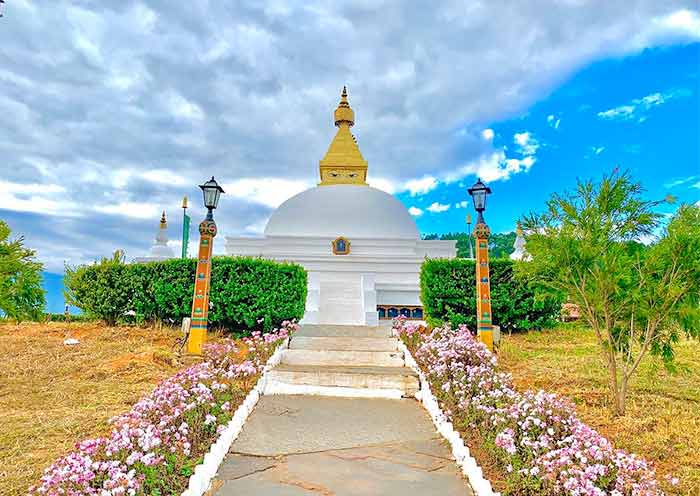
Attractions
3 iconic sites
Transportation
Vehicle
Dining
Breakfast, Lunch, Dinner
Accommodation
Punakha
Today, you will depart Punakha and head back to Paro (110km, about 3.5h) via Dochula Pass again and overnight in Paro after visiting Paro Dzong, Bhutan National Museum.
Along the way, you won't want to miss visiting the famous Tamchog Lhakhang Iron Bridge (view Tachog Lhakhang from outside only), situated by the Paro river. There, you will have the opportunity to walk across a unique iron chain bridge adorned with colorful fluttering prayer flags. Both the Lhakhang and the iron bridge were constructed by the revered saint Thangthong Gyalpo (1385 - 1464), who was renowned as the Iron Bridge Maker. Take delight in exploring his historic architectural creations that have stood the test of time.
After departing from Tamchog Lhakhang Iron Bridge, you will soon arrive in Paro and have the opportunity to visit Paro Dzong (Rinpung Dzong). This magnificent fortress stands tall and proud, serving as a beacon of history and culture in Bhutan. Rinpung Dzong was constructed in 1646 by Shabdrung Ngawang Namgyal (1594-1651), a pivotal figure in Bhutanese history who is revered as the founder of the modern Bhutanese state and a national hero. His enduring legacy continues to shape the country's identity and cultural landscape. Located near the pristine Paro Chu River, Paro Dzong can be accessed via a traditional wooden cantilever bridge, providing you breathtaking panoramic views of the enchanting Paro Valley.
If you hike a little further, you will reach the Bhutan National Museum (Ta Dzong), which holds the distinction of being Bhutan's tallest building. Originally constructed in 1649 as a watchtower overlooking the Paro Dzong, it was later transformed into the National Museum of Bhutan in 1968. At the museum, you can immerse yourself in a rich collection of ancient artifacts such as pottery, armor, thangkas, masks, stamps, photographs, statues, costumes, relics, stone axes, and religious paintings. After the tour, Overnight in Paro.
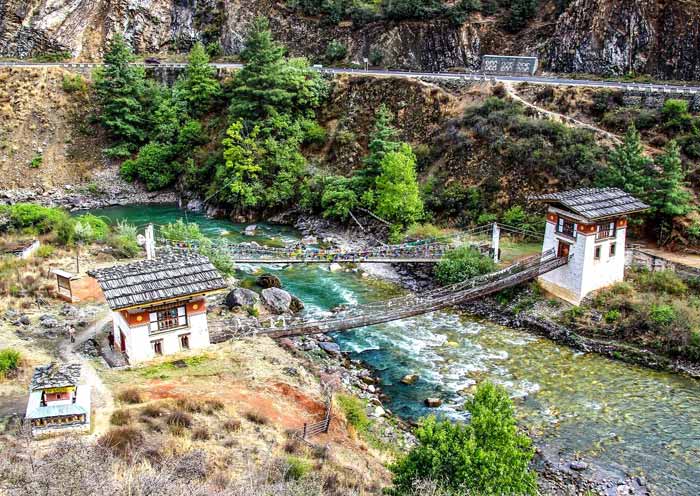


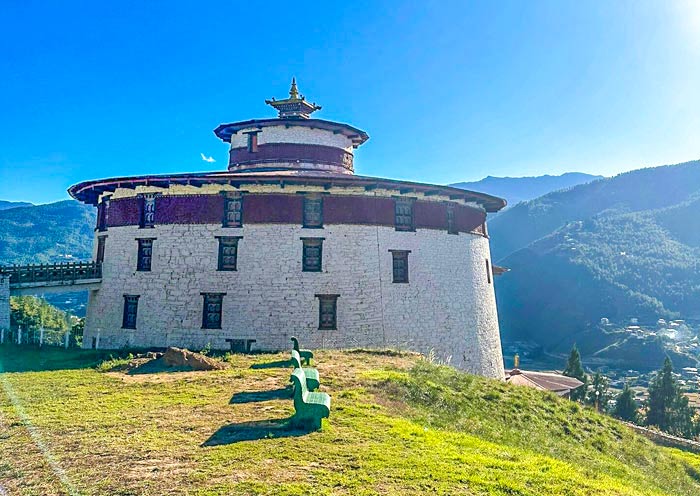
Attractions
3 iconic sites
Transportation
Vehicle
Dining
Breakfast, Lunch, Dinner
Accommodation
Paro
Happiness is a place, wish you had gotten your happiness philosophy from the beautiful Himalayan country with us. It is time to end your 7-day Bhutan Group Tour. Your guide will escort you to Paro International Airport for your flight to your next destination.
Extension Ideas: If you prefer to travel longer in Bhutan, you can extend your trip to other highlighted parts of Bhutan, including Haa, Gangtey, and Bumthang.
Thank you for choosing Asia Odyssey Travel (AOT) for your Bhutan tour, we are always here working for you and hope to see you again for your next trip to China/Asia. Safe journey!


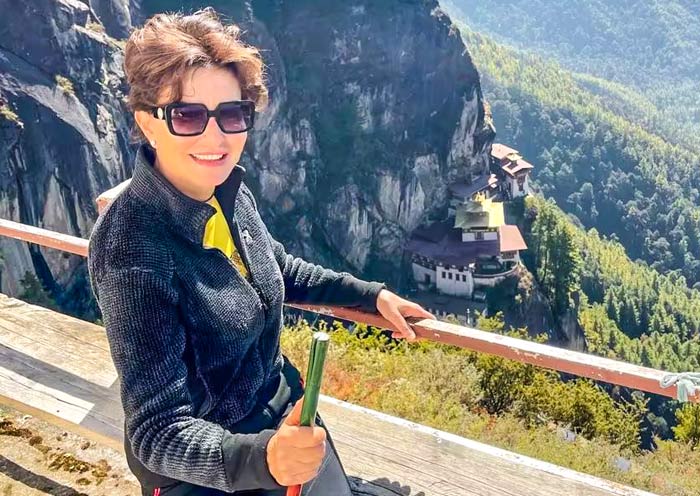

Attractions
Airport See-off
Transportation
Vehicle
Dining
Breakfast
Accommodation
None
Choose Your Travel Date and Get Free Enquiry
| Month | Available Date | Price | Book The Tour |
|---|---|---|---|
| Dec | Dec.14, 2025 | from $1,560 | Free Enquiry |
| Dec.21, 2025 | from $1,560 | Free Enquiry | |
| Dec.28, 2025 | from $1,560 | Free Enquiry | |
| Jan | Jan.04, 2026 | from $1,560 | Free Enquiry |
| Jan.11, 2026 | from $1,560 | Free Enquiry | |
| Jan.18, 2026 | from $1,560 | Free Enquiry | |
| Jan.25, 2026 | from $1,560 | Free Enquiry | |
| Feb | Feb.01, 2026 | from $1,560 | Free Enquiry |
| Feb.08, 2026 | from $1,560 | Free Enquiry | |
| Feb.15, 2026 | from $1,560 | Free Enquiry | |
| Feb.22, 2026 | from $1,560 | Free Enquiry | |
| Mar | Mar.01, 2026 | from $1,560 | Free Enquiry |
| Mar.08, 2026 | from $1,560 | Free Enquiry | |
| Mar.15, 2026 | from $1,560 | Free Enquiry | |
| Mar.22, 2026 | from $1,560 | Free Enquiry | |
| Mar.29, 2026 | from $1,560 | Free Enquiry | |
| Apr | Apr.05, 2026 | from $1,560 | Free Enquiry |
| Apr.12, 2026 | from $1,560 | Free Enquiry | |
| Apr.19, 2026 | from $1,560 | Free Enquiry | |
| Apr.26, 2026 | from $1,560 | Free Enquiry | |
| May | May.03, 2026 | from $1,560 | Free Enquiry |
| May.10, 2026 | from $1,560 | Free Enquiry | |
| May.17, 2026 | from $1,560 | Free Enquiry | |
| May.24, 2026 | from $1,560 | Free Enquiry | |
| May.31, 2026 | from $1,560 | Free Enquiry | |
| Jun | Jun.07, 2026 | from $1,560 | Free Enquiry |
| Jun.21, 2026 | from $1,560 | Free Enquiry | |
| Jul | Jul.05, 2026 | from $1,560 | Free Enquiry |
| Jul.19, 2026 | from $1,560 | Free Enquiry | |
| Aug | Aug.02, 2026 | from $1,560 | Free Enquiry |
| Aug.16, 2026 | from $1,560 | Free Enquiry | |
| Aug.30, 2026 | from $1,560 | Free Enquiry | |
| Sep | Sep.06, 2026 | from $1,560 | Free Enquiry |
| Sep.13, 2026 | from $1,560 | Free Enquiry | |
| Sep.20, 2026 | from $1,560 | Free Enquiry | |
| Sep.27, 2026 | from $1,560 | Free Enquiry | |
| Oct | Oct.04, 2026 | from $1,560 | Free Enquiry |
| Oct.11, 2026 | from $1,560 | Free Enquiry | |
| Oct.18, 2026 | from $1,560 | Free Enquiry | |
| Oct.25, 2026 | from $1,560 | Free Enquiry | |
| Nov | Nov.01, 2026 | from $1,560 | Free Enquiry |
| Nov.08, 2026 | from $1,560 | Free Enquiry | |
| Nov.15, 2026 | from $1,560 | Free Enquiry | |
| Nov.22, 2026 | from $1,560 | Free Enquiry | |
| Nov.29, 2026 | from $1,560 | Free Enquiry | |
| Dec | Dec.06, 2026 | from $1,560 | Free Enquiry |
| Dec.13, 2026 | from $1,560 | Free Enquiry | |
| Dec.20, 2026 | from $1,560 | Free Enquiry | |
| Dec.27, 2026 | from $1,560 | Free Enquiry |
Price: What’s Included & What’s Excluded
What’s Included:
What’s Excluded:
- 01 To join the group tour in Bhutan, a minimum of 1 person is required to make a booking. It is a small group tour, and you will meet your local guide and driver at the Bhutan airport.
- 02 Please note that full payment of the tour fee is required 30 days before the departure date. The tour fee will be transferred to the Royal Bank of Bhutan's account. Once the payment is received, the Bhutanese government will process your visa.
- 03 In Bhutan, there is a strong emphasis on pure spiritual beliefs and environmental conservation. You won't find luxurious shopping centers or excessive packaging during this trip. It is not a luxury vacation but rather a journey focused on experiencing Bhutan's rich historical and cultural heritage and spiritual aspects.
- 04 Bhutanese cuisine prominently features "chili" as its main ingredient. Most dishes include cheese, potatoes and chili. Vegetables primarily consist of legumes and tubers. If you have any dietary restrictions or special meal requirements, please inform us during the tour registration process so that we can make appropriate meal arrangements.
- 05 The tour fee is based on double occupancy, assuming 2 persons sharing a room. If you are a solo traveler or have a specific request for a single room due to personal reasons, there will be an additional charge for a single room supplement.
- 06 Please note that any non-participation in the itinerary will be considered as voluntary abandonment, and no refund will be provided for those activities or locations.
- 07 For the safety and convenience of all travelers, it is not possible to accommodate requests to deviate from the tour itinerary during the trip. The service begins at Paro Airport and ends at Paro Airport.
Hotel Conditions for Bhutan Group Tour




1. Recommended Length of Stay for Bhutan Group Tour: For your group tour in Bhutan, you will stay in 3-star hotels. Typically, you’ll spend 1-2 nights in Paro, 1-2 nights in Thimphu, 1-2 nights in Punakha, with the possibility of 1 night in Trongsa and 2 nights in Bumthang. Accommodations will be in twin-bed standard rooms.
2. All our selected 3-star hotels are in prime locations, usually near the main attractions or Dzongs. Each hotel provides high-quality service, organic food, and clean, comfortable rooms, ensuring a pleasant and comfortable stay at every destination.
3. Single Room Supplement: By default, the tour package assumes two people sharing a room. However, if you require a single room, an additional single room supplement will be charged. This supplement ensures that you have a private room for your stay, providing added comfort and privacy.
4. Check-In and Check-Out Times: Check-in time for the hotels is generally after 14:00 (2:00 PM), allowing you to settle in and freshen up before starting your Bhutanese adventure. On the day of departure, please check out before 12:00 noon to ensure a smooth transition and allow time for the hotel staff to prepare for incoming guests.
Important Trip Notes for Bhutan Group Tours
-
Can I have my own Bhutan group tour?Yes, if you are traveling with a group of friends or with your family, you can customize your own Bhutan group tour. Please contact your professional travel consultant to discuss and arrange a customized group tour thatmeets your needs and preferences.
-
When is the best time to visit Bhutan, and what is the weather like?Climate: The ideal seasons for travel in Bhutan are from March to November when the weather is most suitable.
Off-peak season: From December to February, it is winter and considered the off-peak travel period. During the day, temperatures hover around 15 degrees Celsius, dropping below freezing at night. From June to September, it is summer and the rainy season, with temperatures around 23 degrees Celsius during the day and 15 degrees Celsius at night.
Peak season: The peak travel periods are from March to May and September to November. -
What can I eat during my Bhutan trip?In the Paro region of Bhutan, staple foods include rice, buckwheat, corn, and red rice. Chili and dairy products are commonly used as accompaniments. One of the most famous traditional dishes is Emma Datshi, which consists of chili with cheese. While beef, lamb, and pork are popular meats, it's important to note that Bhutan follows Buddhist principles of non-violence and does not slaughter animals within the country. Most of the meat available in the market is imported from neighboring India and primarily caters to tourists. Beverage options include black tea, butter tea, rice wine, and beer.
-
What should I wear during my visit to Bhutan?Bhutan experiences long hours of sunlight, and the UV rays can be intense. It is recommended to bring your own sunscreen, hat, and wear long-sleeved clothing to protect yourself. Additionally, staying hydrated by drinking plenty of water and consuming fruits is essential.
-
Are there any rules for traveling in Bhutan?Respect for Customs and Regulations: Please show respect for Bhutan's religious customs, traditions, and adhere to the relevant government regulations during your visit.
Cancellation Policy
In the event that you need to cancel your trip, please ensure that you submit a written cancellation request. The calculation of cancellation fees will begin from the date we receive your written request.
The cancellation fees will be calculated as follows:
- If the cancellation is made between 45 and 30 days before the scheduled departure date, a fee of 10% of the full payment per person will apply.
- If the cancellation is made between 29 and 15 days before the scheduled departure date, a fee of 30% of the full payment per person will apply.
- If the cancellation is made between 14 and 7 days before the scheduled departure date, a fee of 50% of the full payment per person will apply.
- If the cancellation is made between 6 and 0 days before the scheduled departure date, a fee of 100% of the full payment per person will apply.
- Note: For Bhutan visas applied with Express Visa Processing, if you cancel after the visa process has commenced, the Sustainable Development Fee (SDF) and visa fee will be non-refundable. The remaining tour costs will follow the cancellation policy outlined above.
Read Latest Reviews about This Bhutan Tour
Overall Rating
Excellent
Itinerary
Excellent
Guide
Excellent
Transport
Excellent
Accommodation
Excellent
Food
Excellent
Tour Operator
Excellent
Latest Bhutan Group Tours Reviews from Our Customers

cindy heng
Malaysia
Date of Experience: Sep 07, 2025
Tour Customized by: Abby
You May be Interested in This Tour: Customized Tour

mui m
Vietnam
Highly recommend Asia Odyssey - they planned a fantastic itinerary against our brief for Tibet, Nepal, and Bhutan. Special shoutout to Ms. Mandy who planned our trip, answered all our questions, was incredibly responsive, and was always helpful. She checked in during our trip to make sure we were okay as well. On our trip, our local guides were knowledgeable and kind and our accommodation was comfortable. All-in-all a fantastic experience and highly recommended.
Thank you for a wonderful experience!!
Destination(s): Tibet
Date of Experience: Jun 05, 2025
Tour Customized by: Mandy
You May be Interested in This Tour: Customized Tour

Bhawani Thangaratnam
Malaysia
Date of Experience: Aug 31, 2025
Tour Customized by: Steven
You May be Interested in This Tour: Customized Tour










